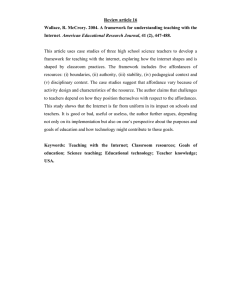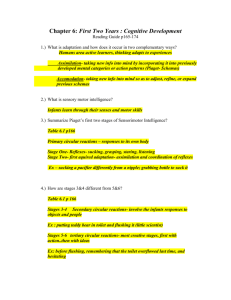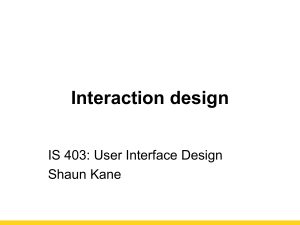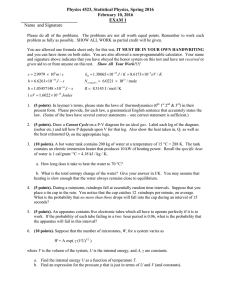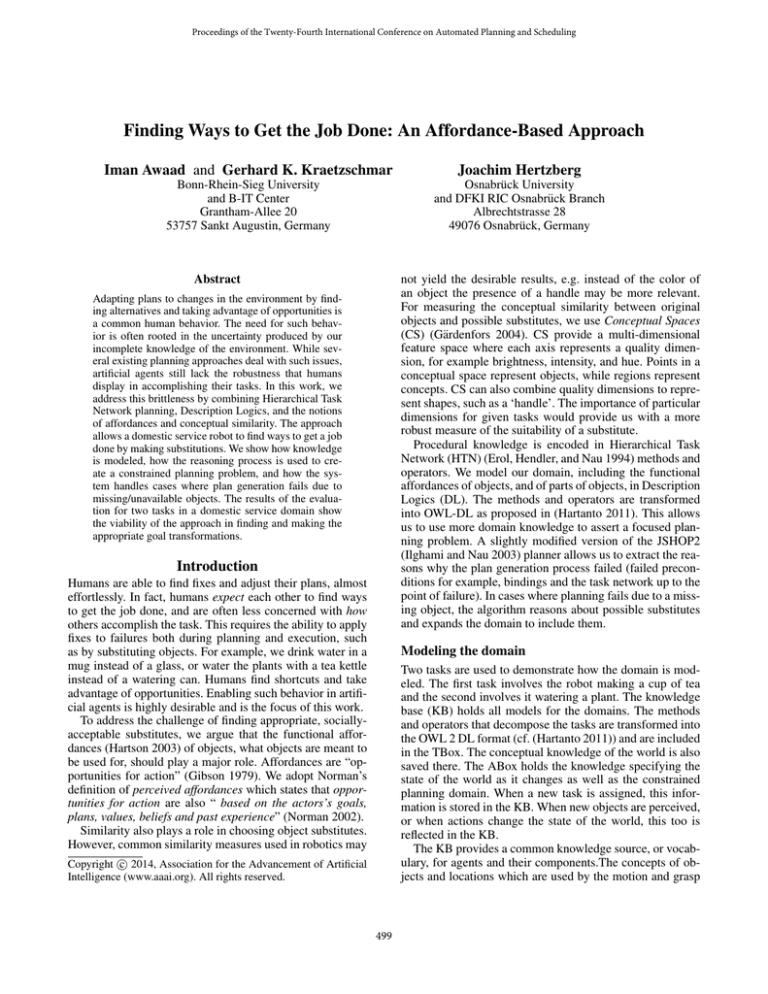
Proceedings of the Twenty-Fourth International Conference on Automated Planning and Scheduling
Finding Ways to Get the Job Done: An Affordance-Based Approach
Iman Awaad and Gerhard K. Kraetzschmar
Joachim Hertzberg
Bonn-Rhein-Sieg University
and B-IT Center
Grantham-Allee 20
53757 Sankt Augustin, Germany
Osnabrück University
and DFKI RIC Osnabrück Branch
Albrechtstrasse 28
49076 Osnabrück, Germany
Abstract
not yield the desirable results, e.g. instead of the color of
an object the presence of a handle may be more relevant.
For measuring the conceptual similarity between original
objects and possible substitutes, we use Conceptual Spaces
(CS) (Gärdenfors 2004). CS provide a multi-dimensional
feature space where each axis represents a quality dimension, for example brightness, intensity, and hue. Points in a
conceptual space represent objects, while regions represent
concepts. CS can also combine quality dimensions to represent shapes, such as a ‘handle’. The importance of particular
dimensions for given tasks would provide us with a more
robust measure of the suitability of a substitute.
Procedural knowledge is encoded in Hierarchical Task
Network (HTN) (Erol, Hendler, and Nau 1994) methods and
operators. We model our domain, including the functional
affordances of objects, and of parts of objects, in Description
Logics (DL). The methods and operators are transformed
into OWL-DL as proposed in (Hartanto 2011). This allows
us to use more domain knowledge to assert a focused planning problem. A slightly modified version of the JSHOP2
(Ilghami and Nau 2003) planner allows us to extract the reasons why the plan generation process failed (failed preconditions for example, bindings and the task network up to the
point of failure). In cases where planning fails due to a missing object, the algorithm reasons about possible substitutes
and expands the domain to include them.
Adapting plans to changes in the environment by finding alternatives and taking advantage of opportunities is
a common human behavior. The need for such behavior is often rooted in the uncertainty produced by our
incomplete knowledge of the environment. While several existing planning approaches deal with such issues,
artificial agents still lack the robustness that humans
display in accomplishing their tasks. In this work, we
address this brittleness by combining Hierarchical Task
Network planning, Description Logics, and the notions
of affordances and conceptual similarity. The approach
allows a domestic service robot to find ways to get a job
done by making substitutions. We show how knowledge
is modeled, how the reasoning process is used to create a constrained planning problem, and how the system handles cases where plan generation fails due to
missing/unavailable objects. The results of the evaluation for two tasks in a domestic service domain show
the viability of the approach in finding and making the
appropriate goal transformations.
Introduction
Humans are able to find fixes and adjust their plans, almost
effortlessly. In fact, humans expect each other to find ways
to get the job done, and are often less concerned with how
others accomplish the task. This requires the ability to apply
fixes to failures both during planning and execution, such
as by substituting objects. For example, we drink water in a
mug instead of a glass, or water the plants with a tea kettle
instead of a watering can. Humans find shortcuts and take
advantage of opportunities. Enabling such behavior in artificial agents is highly desirable and is the focus of this work.
To address the challenge of finding appropriate, sociallyacceptable substitutes, we argue that the functional affordances (Hartson 2003) of objects, what objects are meant to
be used for, should play a major role. Affordances are “opportunities for action” (Gibson 1979). We adopt Norman’s
definition of perceived affordances which states that opportunities for action are also “ based on the actors’s goals,
plans, values, beliefs and past experience” (Norman 2002).
Similarity also plays a role in choosing object substitutes.
However, common similarity measures used in robotics may
Modeling the domain
Two tasks are used to demonstrate how the domain is modeled. The first task involves the robot making a cup of tea
and the second involves it watering a plant. The knowledge
base (KB) holds all models for the domains. The methods
and operators that decompose the tasks are transformed into
the OWL 2 DL format (cf. (Hartanto 2011)) and are included
in the TBox. The conceptual knowledge of the world is also
saved there. The ABox holds the knowledge specifying the
state of the world as it changes as well as the constrained
planning domain. When a new task is assigned, this information is stored in the KB. When new objects are perceived,
or when actions change the state of the world, this too is
reflected in the KB.
The KB provides a common knowledge source, or vocabulary, for agents and their components.The concepts of objects and locations which are used by the motion and grasp
c 2014, Association for the Advancement of Artificial
Copyright Intelligence (www.aaai.org). All rights reserved.
499
ontology is modeled based on the dictionary definition of
objects. No ad hoc categories are created as is often the case.
Dictionary definitions tend to be concise and unambiguous, providing information that would help the perception
components to ‘search’ for the relevant cues and allow them
to trigger afforded behaviors when sensed. In addition, they
also tend to provide the functional affordances of objects.
For example, a teacup, is defined as “a cup from which
tea is drunk” (McKean 2005), and a cup is “a small, bowlshaped container for drinking from, typically having a handle” (McKean 2005). Therefore, dictionaries make ideal
sources to guide the modeling of the ontology.
The models for a cup and a teacup, for example, are given
here in Manchester OWL Syntax:
Figure 1: Sample decomposition of the tea-making task
Class : Cup
SubClassOf : Container
AND (hasObjectToActOn some Liquid)
AND (hasShape some BowlShaped)
AND (isUsedFor some DrinkingFrom)
AND (hasSize only Small)
AND (canHavePart some ObjectPart)
planners originate within this KB, although these planners
also use their own KBs (e.g. OCL in the case of the grasp
planner). Providing task-relevant information to the motion
and grasp planners is also part of the domain model and is
covered in the coming sections.
In addition to the KB, a blackboard is used to communicate lower-level information, in particular, it is where affordance cues (Fritz et al. 2006), in the form of CS quality
dimensions, are posted as the agent moves through its environment while executing a plan. These CS might be of varying complexity (from simple color hues which would cost
very little in terms of perceptual processing to more complex
concepts such as shape which might have been picked up as
part of the plan’s execution) and would be kept in the system
for a given duration. Upon plan failure, the cues which are in
close proximity can be used to identify viable candidates for
substitutions. The same cues allow the agent to take advantage of opportunities as it carries out tasks during execution,
what (Levihn et al. 2013) call “serendipity” in a navigation
domain, although this is currently future work. This is another motivation for a distinct affordance-based approach.
In situations where little is truly within the agent’s control,
it makes sense to consider what opportunities for action the
environment affords, rather than considering those which it
may or may not provide. For example, a cupboard full of
glasses would guide the agent to grasp any of them.
Class : Teacup
EquivalentTo : Cup
AND (hasObjectToActOn some Tea)
AND (isUsedFor some DrinkingFrom)
Functional affordances are modeled by the isUsedFor
property. As a defined class, any instance that is a member of the Cup class and that is used to drink tea
from will be inferred by the reasoner to be a Teacup.
These are necessary and sufficient conditions that enable
the KB to be used for inference and not simply as a
database. In addition to these properties, the Teacup concept also inherits various other properties from the superclass concepts (including additional isUsedFor properties). In this case, it inherits everything from the Cup
and Container superclasses and so inherits everything
described above for Cup, and two more properties inherited from Container: isUsedFor some : Holding and
isUsedFor : some : Transporting.
Holding, Transporting, and DrinkingFrom are all examples of the ActionOnObject concept. This is the superclass of all the functional affordances of objects and parts of
objects.
The isAlsoUsedFor property enables new functional affordances to be learned through experience, for example, by
having been successfully substituted for a task. A bottle is
defined as “a container, typically made of glass or plastic
and with a narrow neck, used for storing drinks or other liquids” (McKean 2005). Should a user drink from the bottle,
the property isAlsoUsedFor some DrinkingFrom would
be added to the Bottle concept. This would also provide a
quick way to look up which objects have previously been approved as substitutes and thus, allows the transfer and re-use
of this knowledge.
We extend the functional view of objects to our actions by modeling the reason why the action is be-
The Tea-Making Task
A sample decomposition specified by methods and operators
in the domain for the tea-making task is given in Figure 1.
It calls for a clean teacup to be used. Substituting objects, in
the case one is not found, is in essence allowing other object
types to bind with the ?teacup variable.
The variable types used in the planning domain are also
modeled as classes in the ontology. The ontology itself
builds on the upper ontology of (Tenorth and Beetz 2009)
and as such includes concepts such as SpatialThing,
TemporalThing, AgentGeneric and so on. Another part
of the ontology models those concepts necessary when converting between OWL and JSHOP syntaxes. The rest of the
500
ing performed so that the motion and grasp planners
can, for example, provide suitable poses. The operator
goTo(?kettle, ForGrasping) shown in Figure 1, for example, communicates the reason why the agent needs to go
to the kettle. This information is used by the motion planner
to take into consideration the necessary constraints in identifying the final pose to reach. These constraints may also be
influenced by the perception components (it needs to be in a
position that would allow it to localize the kettle in order to
proceed with the grasping action). In addition, a constraintbased system for grasping (Schneider 2013) uses the information to verify that the action can indeed be performed using the specified object and with the specified hardware. For
example, the action grasp(?cleanerBottle,ToSpray) would
trigger the system to validate that such a task is possible.
This is important as faults can occur at any time and it is
therefore not sufficient to specify capabilities once. Moreover, these capabilities depend on the agent, the object and
the intended use, hence the use of affordances to link them.
Figure 2: Sample decomposition of the plant-watering task
ing of the objects in CS and learning these weights is actively
being investigated.
The need to transform the plans as well can be seen in
the case a tea kettle is substituted for the watering can. Two
additional actions are necessary to remove the kettle’s lid,
and replace it during filling (as seen in Figure 1). These are
absent from the fill method for the watering can seen in
Figure 2. Once again, the solution lies in the modeling of the
methods and operators in DL. This is detailed in the section
below on expanding the domain.
The Plant-Watering Domain
This scenario serves to highlight the limitation of using functional affordances to make substitutions. When objects have
very specific uses, it is no longer possible to find other objects that share the same affordance in order to make viable
substitutions. Surprisingly, the opposite is also true. When
many objects share the same functional affordance, they
would all be equally likely to be used as substitutes for each
other, although there may be some which, in reality, would
make better substitutes. For example, a glass, teacup, cup,
mug, and bottle may all share the DrinkingFrom concept.
However, the best object to use is very often that which is
most similar to the original. In both these cases, a means to
measure the conceptual similarity between objects would allow the better choice to be made. This example also serves to
motivate that in some situations, the plans themselves may
need to be adapted, and why goal transformation and replanning alone are insufficient.
The domain specification for the plant-watering task
is straightforward. Figure 2 shows a sample task decomposition specifying that a watering can should be
fetched, filled, and used to water a plant. For this scenario, let us assume that a watering can is not available
and so, to avoid failing to accomplish the task, a substitution is attempted. Querying for another object which
isUsedFor Watering Plants yields no instances, and
neither does a query for isUsedFor Watering alone.
As mentioned above, the similarity measures which are
often used may not yield the results we have in mind, hence
our use of CS. Learning the relation between these quality
dimensions and given tasks would allow the agent to choose
the most appropriate object within the KB. For example, for
watering plants, the capacity to hold water is perhaps the
most important concept, followed by the presence of a handle and a spout, and in this case, the relevant query may
return the tea kettle. Such relations could then be used as
weighting factors to determine how well an object would
substitute for another in achieving a given task (similarity is
measured as the weighted Euclidean distance). The model-
Generating the planning problem
Having shown how we model our domain, we now show
how it allows us to generate a constrained planning problem.
By matching a user’s goal to a task, we are able to query our
KB for all methods and operators which could decompose
the given task. This is one of the benefits gained from using
a hierarchical approach.
The approach used in (Hartanto 2011) explicitly specifies,
for each method and operator, a useState variable which
contains a list of states to be included within the initial state.
For example, a navigation domain would include only rooms
with open doors in the initial state. This additional domain
knowledge is what enables the generation of a constrained
planning problem.
A plan is then generated, at least, that is the best-case scenario: we have all the information we need to plan. Unfortunately, things can and do often go wrong. The most likely
scenario is that a method or operator requires that a precondition be met and the KB lacks the information to determine
if it is or isn’t. For example, it contains no information on
whether or not there exists an instance of a clean cup, even
if it knows that all known instances are dirty.
Humans faced with the same situation would still attempt
to proceed with their plan and assume that they will adapt
as need be. As long as there are instances of the object,
we attempt to generate a plan. If the locations of the instances are unknown, this flexibility is achieved by querying
a semantic map and creating dummy instances as needed at
the most probable location. For example, a dummy instance
of clean(cup) may be instantiated in(cupboard4) in the
ABox. This allows the planning process to proceed and increases the chances of success. If the knowledge within our
KB and semantic map does not favor the odds, then, a search
for substitutes is triggered.
Assuming we have sufficient information within our KB
501
tional affordance and yet are conceptually similar, for example a measuring cup; or in the case of the watering can, a tea
kettle.
As previously mentioned, a direct substitution of objects may not produce a sound plan. Therefore, in addition to the objects being included in the newly expanded
domain, the methods and operators which use them are
also included. For example, the m fillFromTap(?kettle)
method with its additional steps replaces the original
m fillFromTap(?wateringCan) method.
To accomplish this, a successful decomposition of the
original task is needed. The domain expansion process therefore involves two stages. In the first stage, the failed preconditions/bindings are ‘corrected’ (e.g. by using a placeholder
instance of a clean teacup) and sent back to the planner so
that it may successfully generate a plan. This process may
be repeated until a plan is generated. Once a decomposition
is available, method and operators that have the substitute
object type as a variable are included in the newly expanded
domain description along with instances of the substitute object. The preconditions (and variables) that referred to the
original object, e.g. have(?teacup), are replaced with the
substitute, e.g. have(?mug), and the planning process is triggered once more to enable the substituted object to be used
in the new plan.
to determine if preconditions are met or not, and even with
the help of these dummy instances, the planner may still fail
to generate a plan due to a failed precondition. For example, all cups may in fact be dirty. In such a case, humans
would consider either washing a cup or making a substitution that would allow them to get the job done. They may
use a mug for instance. Here, we assume that if a method
that would allow the robot to wash a cup while making tea
was desirable to the user, it would have been included in
the tea-making method decomposition and dirty(teacup)
would be the filter condition that would allow that branch to
be taken. However, in our domain, washing the cup is undesirable (because our robot simply can’t wash the cup and
the dishwasher would take too long) and so the agent has no
choice but to attempt a substitution.
If we recall how our planning problem was generated,
the initial state is constrained and only contains Teacup instances, as that is what the methods and operators specify.
The domain needs to be expanded to include the next best
possible substitute for a teacup. Then, a means to enable the
new object to bind to the variables in the existing methods
and operators needs to be found. This is necessary to handle
cases such as the one described above where filling a kettle
to water plants involves additional actions which are missing
from the original plant-watering domain. This is detailed in
the following section.
Current Status and Future Work
Expanding the Domain
The expansion process can be seen as climbing a “flexibility
ladder” where constraints are iteratively decreased in a structured way to provide the flexibility with which to choose
substitutions. Substitutions are attempted when faced with a
situation where the plan generation process has failed. The
planner outputs explanations which include a reason for the
failure, such as the failed preconditions, the bindings which
have been made, as well as the task network up to the point
of failure.
The Control module is responsible for providing the
guidelines to expand the domain. To do this, it combines
functional affordances and conceptual similarity to reason
about the appropriate substitutes. If the goal specified the
use of a unique instance (e.g. my teacup), the domain is
expanded to include other instances of the class which the
given object belongs to, for example, instances of a teacup
would be included in the new problem’s initial state.
If it fails to find such instances and the creation of a
dummy variable is not supported by the semantic map (due
to low or no probabilities), then the domain is expanded to
include instances of objects which satisfy the next set of constraints: objects with the same functional affordance as the
original object and high conceptual similarity, for example a
mug. This seems to be in line with our own preferences.
The next higher level would remove the constraint that
the substitute should be conceptually similar, relying only
on a shared functional affordance, for example, a vacuum
flask. Should the agent not find such objects and given the
old adage that “form follows function” (the form of objects
is based on their function), conceptual similarity is then used
to identify those objects which do not share the same func-
JSHOP2 has been extended to provide the task network, precondition(s) which resulted in the failed planning process
and the bindings. In addition, the state transitions for the
actions, together with the execution monitoring information
allow a temporary component to keep track of the changes
in the world. The KB used for the planning process (currently in the form of a domain file in JSHOP2 syntax) is
also updated when planned sensing actions are performed.
Once this is done, the planner proceeds to generate a plan
with this updated domain. Modular SMACH (Field 2011)
states (state machine-like execution scripts) for each operator can be called dynamically to execute the plans. Individual monitoring actions have been designed and included in
the SMACH scripts to enable the robot to monitor the execution of its actions, thereby providing additional robustness
and enabling the system to re-plan upon failure (Shpieva and
Awaad 2013).
In our ongoing research, we are continuing with the modeling of the domain knowledge in the OWL-DL ontology
which currently includes objects, parts and functional affordances.
Acknowledgments.
Iman Awaad gratefully acknowledges financial support provided by a PhD scholarship from the Graduate Institute of
Bonn-Rhein-Sieg University. The authors thank Elizaveta
Shpieva and Christian Tiefenau for their help in implementing some of the ideas presented here. The authors also thank
the reviewers for their valuable feedback which has helped
to improve this manuscript.
502
References
Erol, K.; Hendler, J.; and Nau, D. S. 1994. HTN planning: Complexity and expressivity. In In Proceedings of
the Twelfth National Conference on Artificial Intelligence
(AAAI-94), 1123–1128. AAAI Press.
Field, T. 2011. SMACH documentation. Online at
http://www.ros.org/wiki/smach/Documentation.
Fritz, G.; Paletta, L.; Dorffner, G.; Breithaupt, R.; and Rome,
E. 2006. Learning predictive features in affordance based
robotic perception systems. In Intelligent Robots and Systems, 2006 IEEE/RSJ International Conference on, 3642–
3647.
Gärdenfors, P. 2004. How to Make the Semantic Web More
Semantic. In Proceedings of the Third International Conference (FOIS 2004), 17–34.
Gibson, J. J. 1979. The ecological approach to visual perception. Houghton Mifflin (Boston).
Hartanto, R., ed. 2011. A Hybrid Deliberative Layer for
Robotic Agents: Fusing DL Reasoning with HTN Planning
in Autonomous Robots. Berlin, Heidelberg: Springer-Verlag.
Hartson, H. R. 2003. Cognitive, physical, sensory, and functional affordances in interaction design. Behaviour & IT
22(5):315–338.
Ilghami, O., and Nau, D. S. 2003. A General Approach
to Synthesize Problem-Specific Planners. Technical Report
CS-TR-4597, UMIACS-TR-2004-40, University of Maryland.
Levihn, M.; Kaelbling, L. P.; Lozano-Perez, T.; and Stilman,
M. 2013. Foresight and reconsideration in hierarchical planning and execution. In IEEE/RSJ - International Conference on Intelligent Robots and Systems (IROS): Workshop
on Cognitive Assistive Systems.
McKean, E., ed. 2005. The New Oxford American Dictionary. Oxford University Press.
Norman, D. 2002. The psychology of everyday things. Basic
Books (New York).
Schneider, S. 2013. Design of a declarative language for
task-oriented grasping and tool-use with dextrous robotic
hands. Master’s thesis, Bonn-Rhein-Sieg University of Applied Sciences, Grantham Allee 20, 53757 St. Augustin,
Germany.
Shpieva, E., and Awaad, I. 2013. Integrating the planning,
execution and monitoring systems for a domestic service
robot. In Workshop on Roboterkontrollarchitekturen at Informatik.
Tenorth, M., and Beetz, M. 2009. KnowRob - knowledge
processing for autonomous personal robots. In Intelligent
Robots and Systems (IROS), 2009 IEEE/RSJ International
Conference on, 4261–4266.
503

